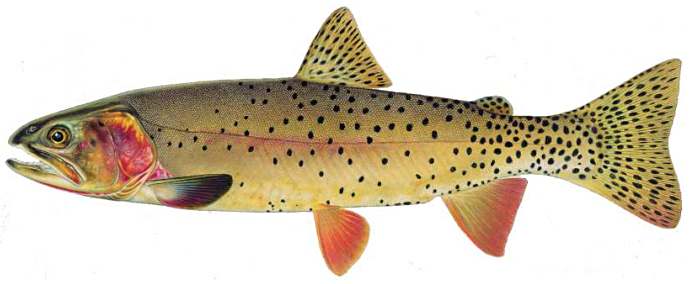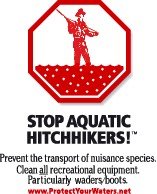CUTTHROAT TROUT
ARE WHIRLING AWAY
ARE WHIRLING AWAY
Malady Spreading Like, - well - Whirling Disease
 .. The Denver Post is just the latest in a long line of newspapers to run a story about the disappearing Cutthroat Trout of Yellowstone. Both the Yellowstone Cutthroat and the West Slope Cutthroat are in trouble.
.. The Denver Post is just the latest in a long line of newspapers to run a story about the disappearing Cutthroat Trout of Yellowstone. Both the Yellowstone Cutthroat and the West Slope Cutthroat are in trouble.
.. In 1995 the New York Times and Peter Kaminsky brought the situation to national attention in their article "Trouble In Paradise." Mike Stark of the Billings Gazette has been diligently writing the same information in articles since 2004, (1, 2.) The Greater Yellowstone Coalition has been involved in the effort to save the species since 2005. The Montana Department of Fish Wildlife And Parks has been acutely aware of the problem since 2001.
.. These natives are disappearing from the regions waters for a variety of reasons, and Whirling disease is not the least of them. Studies have shown the importance of these fish to the ecosystem, and their reduced numbers are alarming.
.. The growing concern stems from the fact that the spawning streams are now infected and the trout are being wiped out in increasing numbers at an increasingly early age. The spawning streams of the Yellowstone River in Paradise Valley and those of the South Fork of the Snake River are now breeding fewer Yellowstone Cutthroats and more parasites.
.. This two year old map shows the
 known distribution of New Zealand Mud Snails in and around Yellowstone National Park. This is almost exactly the same as the known distribution of whirling disease. As you can see the dots follow the Yellowstone River into the Paradise Valley. Here, about 2/3 of the spawning tributaries have shown infected populations.
known distribution of New Zealand Mud Snails in and around Yellowstone National Park. This is almost exactly the same as the known distribution of whirling disease. As you can see the dots follow the Yellowstone River into the Paradise Valley. Here, about 2/3 of the spawning tributaries have shown infected populations.
.. The documentation shows that both are rapidly spreading and reducing the fish population to dangerously low levels.
.. There are a couple of strains of Rainbow Trout, resistant to the disease, that have been developed by fisheries scientists that may be useful in stemming the tide of the disease in this species of trout. However,
 there are no known Cutthroat Trout that are resistant to whirling disease.
there are no known Cutthroat Trout that are resistant to whirling disease.
.. In addition to whirling disease the native Yellowstone Cutthroats are being hybridized out of existence in most waters in the Yellowstone ecosystem. (See: Keeley for the work in Idaho, 1, 2, 3, 4.)
.. The National Park Service advises each fisher on Slough Creek to kill up to five (5) Rainbow Trout that they catch there: provided they can tell the difference.
-------
Money Quotes: NPS
.. Of course the unthinking fly fisher believes that catch-and-release is a panacea for all situations, in all places, and at all times. and has refused to do this in any meaningful way on Slough Creek.
Money Quotes: NPS
To reduce competition, predation, and hybridization stress on native fishes, Yellowstone has increased harvest limits of rainbow and brown trout in waters where they co-exist with cutthroat trout and fluvial arctic grayling.
In cutthroat trout waters where rainbow trout have been introduced, either by intentional, historic stocking or by invasion from a downstream source, the result has been a serious degradation of the cutthroat trout population through interbreeding of the two species.
Harvest of nonnative trout is allowed, and in some cases required, in many park waters.
.. You should hear the patter in the local fly shops. "Hell one trout's as good as the next, and those cutts are lazy fish, anyway." "I'd rather kill a Cuttthroat than a Brown any day." "There's no difference between a Cutbow, a Rainbow, and a Cutthroat." and so it goes.
.. In addition to New Zealand Mud Snails, Lake Trout, Whirling Disease, and Hybridization it might be that the most dangerous invasive species, for the native Yellowstone Cutthroat, is Homo Sapiens. Hardly sapient in this instance.

.. The long history of our manipulation of the fisheries around us, gives pause to the thought that we can or should do anything now. Yet the fish of the Thorofare may be the next to go the way of the downstream populations.
.. These gems are wild, wily, and cagey. They are prey for bears, coyotes, pelicans, eagles, hawks, wolves, and man, for starters. It would be a shame to see them disappear as both a sport fish and a member of the food chain.
.. As the hint of Spring brings to mind fishing in Yellowstone, it also reminds us that it is the informed fisher that enjoys the pastime the most. The history of fish species in Yellowstone has informed the park's managers in their drafting of regulations. It behooves the fisher to be at least as well informed as the managers.
-------
.. There are much better resources on-line about Yellowstone Fishing than you get in the little pamphlet that comes with your fishing permit. The following are exceptionally well written and should be read and understood before fishing in Yellowstone.
.. And, again, this year there are changes. We post this now, AND, let you know that we will post it again as fishing-time draws near.
.. Yellowstone Fishing Regulations (PDF)
.. Yellowstone Fishing Season Dates And Regulations
.. Yellowstone Fishing And Fisheries Science
.. Yellowstone Park Advice To Anglers
.. Fish Identification Tools - Poster Downloads (PDF)
.. Yellowstone Fish Distribution Maps
-------
NPS RECOMMENDED LINKS
Fishing in Yellowstone - YNP Site
Invasive Threats to Yellowstone Fisheries - YNP Site
Whirling Disease Initiative - Montana State University Site
Stop Aquatic Hitchhikers - A public awareness campaign, and a program of the U.S. Fish and Wildlife Service and the U.S. Coast Guard.
National Invasive Species Information Center - US Department of Agriculture Site
Aquatic Nuisance Species - US Environmental Protection Agency Site, Region 8
Montana University System Water Center - Montana State University Site
Aquatic Nuisance Species Task Force - Unites States Federal Aquatic Nuisance Species Task Force Site
Whirling Disease Information - Whirling Disease Foundation Site
New Zealand Mudsnail Information - Montana State University Site
Aquatic Invasive Species - Wisconsin State Environmental Resource Center Site
National Aquatic Nuisance Species Clearinghouse - New York Sea Grant Site
---------
.. The weekend was busy and we had barely time to fish or to visit THE HORSE'S MOUTH. But we did both. One of the cutest wahines ever was posted on Good Friday. And, just in case you missed the week before we reproduce below one of the most daring of all Friday wahines.




.jpg)




